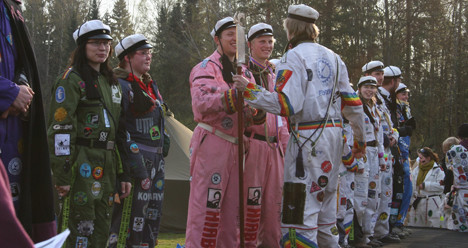
Being a teekkari
Being a teekkari is an identity, created for the students of the Helsinki University of Technology by their studies, and activities in guilds, associations and the Student Union. The central part of being a teekkari is knowing and accepting the traditions and history of the teekkaris. Being a teekkari is a collective experience; through knowing the history and the traditions a teekkari feels connected with present and previous teekkaris. There is not one standardized way of being a teekkari. It is formed by personal experiences and each and every teekkari is practising it in their own way. This page portrays some of the things that are generally associated with being a teekkari.
Teekkari Cap
The teekkari cap is similar to the Finnish student cap. It is a hexagonal cap covered with white velvet. The cap’s band is black velvet and the peak patent leather (plastic these days). A black tassel is attached to the cap and it is hanging over the right side of the cap. The TKY’s badge is used as a cockade on the teekkari cap.
You can recognize a TKY’s teekkari cap for its distinguishing red lining and the cockade, which is a reduction of the TKY’s badge and about 15 mm in diameter. On TF’s (a Swedish nation inside the TKY) cap the cockade is 25 mm in diameter and the lining is in the nation’s colours (red-yellow-red).
For historical reasons the teekkari cap can only be used during the summer months during 1 May to 30 September. You need to apply for permission from the TKY’s Teekkari section if you want to use the cap outside the summer months. The teekkari cap is a sign of a cheerful gentlewoman or gentleman.
Overalls
Overalls are considered as a mark of being teekkari as much as the tasselled cap. The coming of the Swedish overall tradition into Finland in the early 80s can be largely contributed to the teekkaris. From then on the use of overalls has become a norm among Finnish students. Unfortunately students with overalls, having occasionally caused public offence, are usually seen as teekkaris.
Despite of the labelling and risk of negative attention, the overalls are a very popular outfit in Otaniemi. Overalls are practical when partying, and during excursions it is carried with pride as a representative outfit!
Teekkari ribbon
The teekkari ribbon is a red ribbon, 200 mm wide, garnished on both sides with 3 mm wide white stripes. The ribbon is worn, regardless of the wearer’s sex, in a away that it goes over the right shoulder and diagonally over the chest. It is not appropriate to wear the ribbon on bare skin, which often causes problems with ball gowns. Women are allowed to pleat the ribbon into a rosette which is them worn on the gowns left side. The teekkari ribbon can be worn by TKY’s current and former members. The ribbon is usually worn in academic occasions or when representing the Student Union.
You can buy a teekkari ribbon from the TKY’s secretariat’s teekkari service. A short ribbon costs € 1 and a long ribbon € 2. There you can also acquire instructions for tying a rosette.
Tempaukset
Tempaukset are a teekkari way of influencing the world with humorous moves taken with genuine intention. Tempaukset utilize the numbers of teekkaris to raise public interest on various general problems. The tempaukset have also often been used for raising money for charitable purposes.
Earliest TKY tempaukset were acts in participating in supporting the Finnish Olympic team. This happened in 1924, 1928, 1932 and 1936. At that time tempaukset were usually an impressive advertisement parade through the town and number of various parties. This was always done on orders from a certain mysterious “Jämeräpartainen Insinööri” or an Engineer with a Stout Beard, and all teekkaris were obligated to follow his orders. Freshmen especially were to devout their time and energy for the tempaukset.
Jäynät
A jäynä is a humorous, harmless mischievous prank, aimed at humouring its perpetrators, but just as well the target of the jäynä. Jäynä’s should never cause resentment or material damages.
